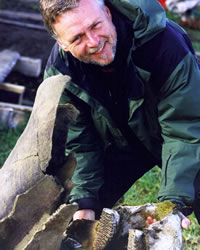Reverse coursePaleontologists seek evidence that marsupials arose in AntarcticaPosted January 14, 2011
Ever see the logo for the Sherwin-Williams Company? It shows a bucket of paint tipped over above the planet. The paint covers the Northern Hemisphere, oozing and dripping south. Ross MacPhee This austral summer he’ll make a fourth attempt to find mammalian fossils that at least prove some kinds of these land animals were present on the continent long before Antarctica finally separated from other land masses and started to go into a deep freeze 40 million years ago. Before then, Antarctica was sandwiched between South America and Australia, all remnants of the former supercontinent Gondwana. MacPhee is particularly interested in the history of Australian marsupials, believing that their ancestors emerged in South America and traveled across Antarctica to Australia sometime in the neighborhood of 80 million years ago. “It was relatively easy, not only for the small guys like the marsupials, but also bigger ones like some of the southern ungulates [hoofed animals] to get across the land bridge connecting Antarctica and South America and settle down until Antarctic winter came in permanently about 40 million years ago,” MacPhee said during an interview at the American Museum of Natural History The problem is that fossil record from Antarctica is spotty at best, especially considering most of the continent is entombed in ice. “That leaves you with a few little windows of seasonally bare ground on the Antarctic Peninsula and nearby islands,” MacPhee noted. One of the better windows is on Seymour Island off the tip of the Antarctic Peninsula. Almost 30 years ago, U.S. scientists in the journal Science described the first fossil land mammal found in Antarctica, belonging to the extinct marsupial family Polydolopidae. The fossils were recovered from rocks about 45 million years old. The find strengthened the theory that Australian marsupials originated from South American species that dispersed across Antarctica prior to about 65 million years ago, MacPhee said. Marsupials are mammals that are distinguished by the pouches many of them use to carry their young — the most well-known examples being kangaroos. More recently, a study published last summer in the online journal PLoS Biology uses DNA data to suggest that Australian marsupials evolved from a common South American ancestor well before the end of the Cretaceous period 65 million years ago when the dinosaurs famously met their end. 
Photo Credit: AMNH
Ross MacPhee
MacPhee, “wildly” but enthusiastically speculating on what he might find during his upcoming expedition, said the possible discovery of marsupial fossils on Seymour or neighboring islands as primitive as those in South America could indicate that the divergence (or origin) of Australian marsupials actually began in Antarctica rather than South America proper. “It would be damn interesting. It implies that Antarctica has been more than a superhighway for species to occasionally traverse,” he said. “It means that during times like the late Cretaceous, when it was much warmer than today, important episodes in mammal evolution might have happened there.” Antarctica of 80 million years ago would hardly resemble the frozen wasteland of today. Some regions would have sported highly diverse vegetation, based on paleobotanical evidence. That means a temperate climate, which favors mammals. “Since there was a great variety of plants, that implies there would have been a commensurately great variety of arthropods and insects, which means there would have been all kinds of available niches for mammals — small mammals, in particular — that eat insects,” MacPhee said. 1 2 Next |



For USAP Participants |
For The Public |
For Researchers and EducatorsContact UsU.S. National Science FoundationOffice of Polar Programs Geosciences Directorate 2415 Eisenhower Avenue, Suite W7100 Alexandria, VA 22314 Sign up for the NSF Office of Polar Programs newsletter and events. Feedback Form |



